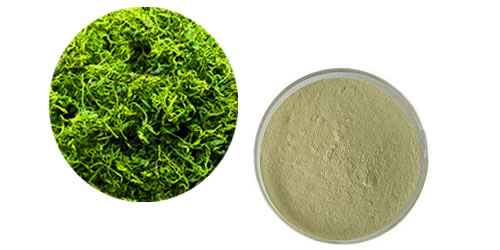[product name]: Gynostemma pentaphyllum extract
[English name]: Gynostemma sapoins
[source of product]: it's the whole grass of gyenostema Pentaphyllum (Thunb.) Mak
[product specification]: 20% 40% 60% 80% 95% 98%
[property]: Brown to white powder, bitter and odorless
[test method]: UV
[shelf life]: two years
[package description]: double plastic bag plus cardboard barrel (25kg / barrel)
[introduction to Gynostemma pentaphyllum]:
Gynostemma pentaphyllum is a perennial plant, which is widely distributed in subtropical and northern subtropical areas. It has the effect of cold nature, sweet taste, invigorating Qi, calming nerves and lowering blood pressure. It is called "magic" longevity medicine by the people. In the spark plan, it is listed as the first "precious Chinese medicine". Some enterprises process it into Gynostemma pentaphyllum tea, which is convenient for people to drink.

[habitat distribution]:
It grows in the dense forest in the valley, under the sparse forest on the hillside or in the Bush at an altitude of 100-3200m. Like warm climate, humid environment, avoid direct sunlight, poor drought resistance. The requirement of soil condition is not strict. It is better to plant under the mountain forest or in the valley on the shady slope, and the fertile and loose sandy loam is better. China, India, Nepal, Sikkim, Bangladesh, Southeast Asia, Korean Peninsula and Japan have distribution.
[origin]:
Our main products are Shennongjia, Wushan, Wuxi, Chengkou, Enshi, Xiushan, Fengjie, Kaixian, Shizhu and Wulong. Nanchuan, Banan, Nan'an, Beibei, Jiangjin and Tongliang are also distributed.
[resource protection]:
There are abundant wild Gynostemma resources in the Three Gorges area. In the early 1990s, a large number of drug dealers purchased Gynostemma pentaphyllum. In order to obtain higher output and higher income, the masses adopted the way of uprooting a large number of mining, resulting in a sharp reduction of wild resources. At present, wild Gynostemma pentaphyllum has been listed as the second class protected plant by the State Forestry Administration. We should strengthen the protection of wild germplasm resources of Gynostemma pentaphyllum in the Three Gorges area, and vigorously carry out the popularization of Gynostemma pentaphyllum planting technology to meet the market demand.
[plant morphology]:
Perennial climbing herb. Stems slender, glabrous or sparsely pilose, many branched, with longitudinal ribs and grooves. Leaves alternate, tendrils slender, 2-way, sparse and single. The leaves are bird foot shaped, with 5-7 leaflets, oval oblong or oblong lanceolate, the central leaflet is larger than the lateral leaflet, the edge has wavy teeth or round teeth, and both sides are covered with short bristles. The male flower is a panicle of dioecious plant, the inflorescence spike is thin and many branches, the base of which has subulate bracteoles, the calyx tube is very short, 5-lobed, and the lobes are triangular; the Corolla is light green, 5-deep-split; the stamens are 5, the filaments are short, combined into a column. Female flowers are panicles, smaller than male flowers, calyx, corolla like male flowers, ovary spherical, style 3, short and bifurcated, stigma 2-lobed, with 5 short staminodes. The fruit is spherical and black after ripening.
[chemical constituents of Gynostemma pentaphyllum]:
Gynostemma pentaphyllum mainly contains saponins, the highest content is in leaves, followed by stems and aboveground parts. Its basic structure is damane type tetracyclic triterpenoids. It also includes flavonoid glycosides, sugars, sterols, organic acids, pigments, cellulose, plant proteins, starch, etc.
Saponins
The content of saponins in Gynostemma pentaphyllum is an important index to evaluate the quality of Gynostemma pentaphyllum. It is mainly distributed in assimilation tissue and phloem parenchyma cells of vegetative organs. The content varies with varieties and environment, generally 2% - 8% of dry weight. There are 4 ginsenosides in gypenosides. Among them, Gypenoside Ⅲ, Ⅳ and Ⅷ are ginsenoside Rb1, RB3 and RD respectively, and Panaxadiol, 2 α, 19-dihydroxy-12-deoxypanaxadiol and Gypenoside a. The content of total saponins is three times that of ginseng. Gynostemma pentaphyllum is the only plant which contains ginsenoside except ginseng in Acanthopanax family, and the content of Ginsenoside in excellent plants is even higher than that of ginseng.
2. Flavonoids
More than 10 flavonoids, such as SH-4, phytolac, phytolac, rutin, gypenone 2a, howlolin, malonic acid and malonic acid.
3. Polysaccharide
The stems and leaves of Gynostemma pentaphyllum contain fructose, glucose, galactose and oligosaccharide, and the hydrolysates contain rhamnose, xylose, arabinose, glucose and galactose.
4. Others
Gynostemma pentaphyllum also contains 18 kinds of amino acids, sugars, cellulose, sterols, pigments, 23 kinds of microelements and so on.